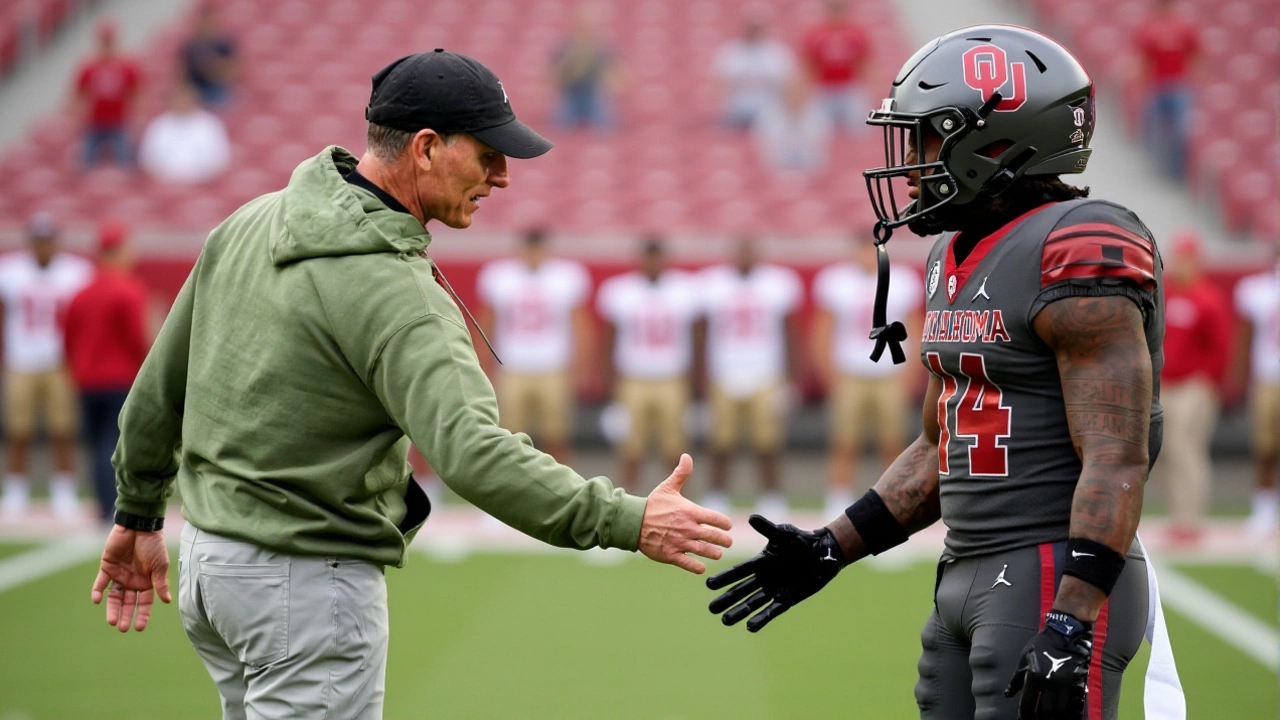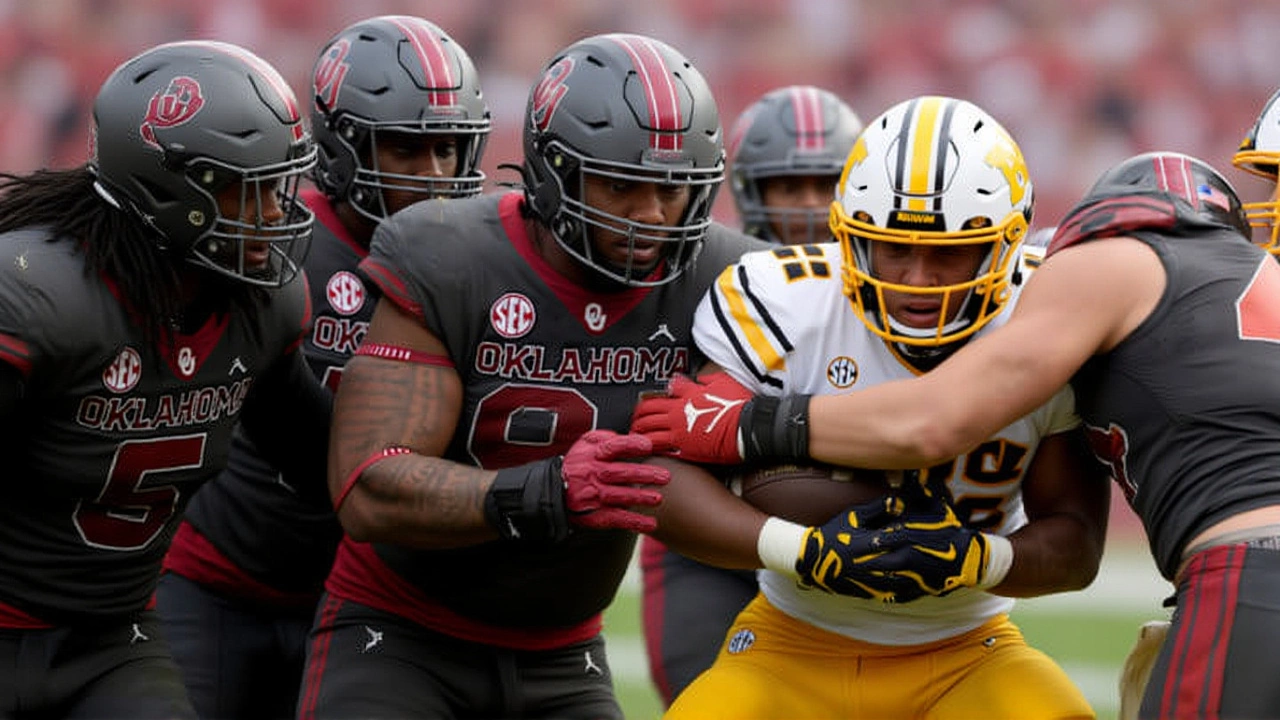When the final whistle blew at Gaylord Family-Oklahoma Memorial Stadium on November 22, 2025, the Oklahoma Sooners had done more than just win — they’d kept their College Football Playoff dreams alive. Beating the Missouri Tigers 30-18 in front of a roaring home crowd, Oklahoma improved to 9-2, while Missouri slipped to 7-4. The game, broadcast on ABC, wasn’t just another conference clash. It was a turning point — one that could determine whether the Sooners make their first playoff appearance since 2020.
The Game That Changed Everything
It wasn’t pretty, but it was effective. Oklahoma’s defense, ranked 8th nationally in points allowed (14.8 per game), held Missouri’s explosive offense — which had averaged 34.9 points — to just 18. The Tigers came in riding high after a 49-27 demolition of Mississippi State, where running back Ahmad Hardy rushed for 300 yards. But in Norman, the Sooners’ front seven turned him into just another name on the stat sheet. Hardy finished with 82 yards on 18 carries — less than half his season average.
Meanwhile, Oklahoma’s offense, often criticized for being too slow, found its rhythm. With Heisman favorite quarterback John Mateer sidelined by a hand injury, backup Beau Pribula stepped up with precision, throwing for 217 yards and two touchdowns. But the real story was the ground game. Running back Dakota Jones rushed for 142 yards and two scores, including a 42-yard burst in the third quarter that broke open a 13-13 tie.
Why the Spread Was Misleading
Oddsmakers opened Oklahoma as a 6.5-point favorite, then saw the line swing wildly — FOX Sports had it at 7.5, CBS Sports dropped it to 5.5. Why the confusion? Because Missouri’s offense looked unstoppable on paper. Hardy led the nation in rushing yards (1,346) and touchdowns (15). Wide receiver Kevin Coleman Jr. had 600 receiving yards. But the Tigers’ defense? Ranked 25th nationally, they’d given up 30+ points in four of their last six games.
The real edge wasn’t in the spread — it was in the context. Oklahoma had won six of their last seven games against teams ranked in the top 25. Missouri, meanwhile, had lost three of their last four on the road. And here’s the kicker: in their last six meetings, the total points had never dipped below 52.5. This time? 48. The over-under of 42.5 was a trap for bettors expecting fireworks. The Sooners didn’t need them. They needed control. And they got it.

What the Numbers Didn’t Tell You
Stat sheets don’t capture momentum. But fans in Norman felt it. The crowd noise hit 102 decibels when Oklahoma forced a fumble on Missouri’s opening drive — recovered by linebacker Malik Turner. That play set the tone. The Sooners’ defense forced three turnovers total, including a critical interception by safety Isaiah Carter in the red zone late in the third quarter.
Missouri’s offense, which had averaged 7.1 yards per play in their last three wins, managed just 4.9 against Oklahoma. Quarterback Beau Pribula, who had thrown 11 touchdowns in his last four games, was held to just 127 yards after halftime. His final pass — a desperation heave into the end zone on fourth down with 1:12 left — was batted down by defensive end Brady Henson.
And then there was the weather. A cold front swept through Norman that morning. Temperatures dropped to 38°F. The Sooners, used to playing in the Oklahoma chill, thrived. Missouri’s players, coming from Columbia’s milder climate, looked sluggish. One Tiger lineman told reporters afterward: "We weren’t ready for how hard it hit. It felt like winter hit us in the face."
The Playoff Path Narrowed — But Still Open
After the win, Oklahoma’s record improved to 9-2. But the celebration was muted. Because the real test was still ahead. As The Oklahoman reported on November 22, the Sooners needed to beat LSU on November 29, 2025, to have any shot at the College Football Playoff. And LSU? They were 10-1, ranked #5, and coming off a 45-10 thrashing of Alabama.
By November 24, the College Football News Coaches Poll listed Oklahoma at #8 — still in the conversation, but barely. Missouri, despite a strong season, didn’t crack the top 25. They finished the year ranked among "Top Projected Teams Also Receiving Votes," alongside Navy and Washington.
"This win doesn’t guarantee anything," said Oklahoma head coach Brent Venables after the game. "But it proves we can win the big ones. Now we have to go on the road and do it again."

What’s Next?
With LSU looming, Oklahoma’s playoff hopes rest on one game. If they win, they’ll likely leapfrog teams like Iowa and Washington. If they lose? Their season ends with a Sugar Bowl bid — still a great outcome, but not the one they wanted.
Missouri’s season is over. But the future looks brighter than the record suggests. Ahmad Hardy is returning next year. Kevin Coleman Jr. is a senior, but his production makes him a first-round NFL draft prospect. And Beau Pribula? He showed he can lead under pressure. This wasn’t a collapse. It was a lesson.
Frequently Asked Questions
How did Oklahoma’s defense shut down Ahmad Hardy so effectively?
Oklahoma’s defensive line, led by Brady Henson and Malik Turner, focused on clogging running lanes and forcing Hardy to the outside, where linebackers could swarm him. They also used a safety blitz on 11 of his 18 carries, disrupting his timing. Hardy’s 82 yards were his lowest total since Week 3, and he had zero runs over 15 yards — a stark contrast to his 300-yard game against Mississippi State.
Why did the over-under of 42.5 points fail despite historical trends?
While the last six meetings between these teams averaged over 52 points, this game was a defensive battle. Oklahoma’s strategy was to control the clock, limit possessions, and force Missouri into third-and-long situations. They ran 71 plays to Missouri’s 52, holding the ball for over 38 minutes. That tempo, combined with three turnovers, kept the scoreboard low — proving that past trends don’t always predict future outcomes.
What role did John Mateer’s injury play in Oklahoma’s performance?
Mateer’s absence forced Oklahoma to rely less on explosive passing and more on a balanced, physical attack. While his dual-threat ability was missed, backup Beau Pribula managed the game efficiently, avoiding mistakes. The offense didn’t need fireworks — it needed consistency. And in a high-stakes game, that was the smarter play. Mateer’s injury may have saved Oklahoma’s season by forcing them to adapt.
Can Missouri still make a bowl game despite their 7-4 record?
Yes. Missouri is bowl-eligible with seven wins and will likely receive an invitation to the Liberty Bowl or the Texas Bowl. Their strong rushing attack and improvement over the second half of the season make them an attractive opponent for bowls looking for offensive firepower. The Tigers have a solid recruiting class coming in, and this season’s experience will help them contend in the SEC next year.
What are Oklahoma’s chances against LSU in their final game?
Oklahoma’s chances are slim but not impossible. LSU is 10-1, ranked #5, and has the nation’s second-best defense. But Oklahoma has won four of their last five games against top-10 teams, and their defense has improved dramatically since October. If they can contain LSU’s quarterback and force turnovers, they can pull off the upset. A win would likely vault them into the top four. A loss? They’ll be left out — again.
Why wasn’t Missouri ranked in the final Coaches Poll?
Despite a 7-4 record, Missouri lost three games by double digits — including a 38-10 defeat to Alabama and a 27-17 loss to Texas A&M. Their only wins over ranked teams were against unranked opponents. The Coaches Poll values strength of schedule and quality wins. Missouri’s resume lacked those, and their loss to Oklahoma — a team that beat Alabama — hurt their case. They’re close, but not quite there yet.


